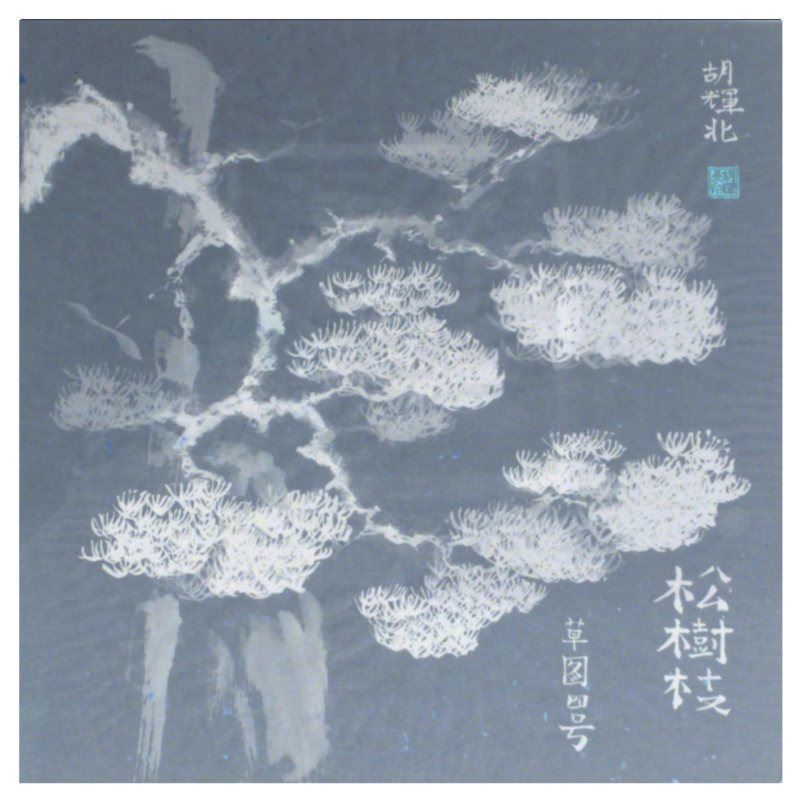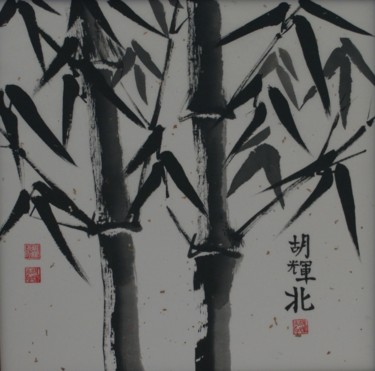Hu Hei Bei
Once and again life guided me to East Asia (Japan, Singapore and Hong Kong) and back to Germany. It was in my early twenties when I first visited Japan:
I was overwhelmed by the unreachable, untouchable beauty of traditional Geishas and I was deeply impressed by the variety of emotions which can be expressed by a single stroke of a brush with black ink on a sheet of rice paper.
It took nearly half a lifetime before I had the opportunity to attend the first professional art lessons.
Mildred Hsu Yee Wong (Painterland Studios, Hong Kong) helped me to develop a deep understanding of Chinese culture. She told me how to find the unity of spirit, body, brush, ink and paper and thus to control the flow of the water. All my capability in traditional Chinese painting and calligraphy I owe to Mildred.
After going back to Germany in 2006 I started to learn the basics of Western painting and drawing at Lübeck School of Arts. In all these years I have been dealing with a huge range of different materials, techniques, styles and subjects.
Corresponding to my experience of life I developed a great variety of artworks from minimalistic or puristic Chinese paintings of e.g. a bamboo or a pine tree or a beautyful face to an explosion of colours and dissolving structures which you can find in the Western world.
I am deeply impressed by the postimpressionist masters (e,g, Matisse, Vallotton, Jawlensky, Derain) and by the old Chinese and Japanese masters of ink painting and calligraphy.
My Chinese paintings and calligraphy are signed and sealed with my Chinese name "Hu Hei Bei".
In my account "Herbert Ruf" on Artmajeur you can find a small collection of my 'Western-style' artworks.
Education:
* 1949
1998 - 2002
Musik- und Kunstschule Lübeck
Watercolour Painting and some Basics in Printing
2003 - 2006
Painterland-Studios Hong Kong
Chinese Calligraphy and Traditional Chinese Painting
2006 until today
Kunstschule der Gemeinnützigen Lübeck
Portraits, Figures, Landscapes and more in Acryl, Pastel, Charcoal and Ink
Exhibitions:
2019 SwissArtExpo Zurich
Painting "Young Chinese Nr. 1" is presented by ArtboxProject
2017 Art Basel Basel
Painting "Couple II" is presented by ArtboxProject
11/2016 - 02/2017
"Impressions of the Far East"
Chinese/Japanese Calligraphy and Ink Painting
MedicalCentre Lübeck
2016 Art Basel Miami
Drawing "Geisha I" is presented by ArtboxProject
01/2016 - 03/2016
"Humans, Sea and Light"
Portraits and Seascape in Acrylic and Pastell
Jacques Weindepot Lübeck
01/2014 - 05/2014
Art on Rice Paper (Chinese Paintings and Calligraphy)
Ärztehaus vor dem Mühlentor Lübeck
11/2012 - 03/2013
Art on Rice Paper (Chinese Paintings and Calligraphy)
Dao-Haus Lübeck
Discover contemporary artworks by Hu Hei Bei, browse recent artworks and buy online. Categories: contemporary german artists. Artistic domains: Painting, Drawing. Account type: Artist , member since 2018 (Country of origin Germany). Buy Hu Hei Bei's latest works on ArtMajeur: Discover great art by contemporary artist Hu Hei Bei. Browse artworks, buy original art or high end prints.

Artist Value, Biography, Artist's studio:
0 artwork by Hu Hei Bei (Selection)
Download as PDFView all artworks
Recognition
The artist's works have been noticed by the editorial staff
The artist is sold in galleries
Biography
Once and again life guided me to East Asia (Japan, Singapore and Hong Kong) and back to Germany. It was in my early twenties when I first visited Japan:
I was overwhelmed by the unreachable, untouchable beauty of traditional Geishas and I was deeply impressed by the variety of emotions which can be expressed by a single stroke of a brush with black ink on a sheet of rice paper.
It took nearly half a lifetime before I had the opportunity to attend the first professional art lessons.
Mildred Hsu Yee Wong (Painterland Studios, Hong Kong) helped me to develop a deep understanding of Chinese culture. She told me how to find the unity of spirit, body, brush, ink and paper and thus to control the flow of the water. All my capability in traditional Chinese painting and calligraphy I owe to Mildred.
After going back to Germany in 2006 I started to learn the basics of Western painting and drawing at Lübeck School of Arts. In all these years I have been dealing with a huge range of different materials, techniques, styles and subjects.
Corresponding to my experience of life I developed a great variety of artworks from minimalistic or puristic Chinese paintings of e.g. a bamboo or a pine tree or a beautyful face to an explosion of colours and dissolving structures which you can find in the Western world.
I am deeply impressed by the postimpressionist masters (e,g, Matisse, Vallotton, Jawlensky, Derain) and by the old Chinese and Japanese masters of ink painting and calligraphy.
My Chinese paintings and calligraphy are signed and sealed with my Chinese name "Hu Hei Bei".
In my account "Herbert Ruf" on Artmajeur you can find a small collection of my 'Western-style' artworks.
Education:
* 1949
1998 - 2002
Musik- und Kunstschule Lübeck
Watercolour Painting and some Basics in Printing
2003 - 2006
Painterland-Studios Hong Kong
Chinese Calligraphy and Traditional Chinese Painting
2006 until today
Kunstschule der Gemeinnützigen Lübeck
Portraits, Figures, Landscapes and more in Acryl, Pastel, Charcoal and Ink
Exhibitions:
2019 SwissArtExpo Zurich
Painting "Young Chinese Nr. 1" is presented by ArtboxProject
2017 Art Basel Basel
Painting "Couple II" is presented by ArtboxProject
11/2016 - 02/2017
"Impressions of the Far East"
Chinese/Japanese Calligraphy and Ink Painting
MedicalCentre Lübeck
2016 Art Basel Miami
Drawing "Geisha I" is presented by ArtboxProject
01/2016 - 03/2016
"Humans, Sea and Light"
Portraits and Seascape in Acrylic and Pastell
Jacques Weindepot Lübeck
01/2014 - 05/2014
Art on Rice Paper (Chinese Paintings and Calligraphy)
Ärztehaus vor dem Mühlentor Lübeck
11/2012 - 03/2013
Art on Rice Paper (Chinese Paintings and Calligraphy)
Dao-Haus Lübeck
-
Nationality:
GERMANY

- Date of birth : 1949
- Artistic domains:
- Groups: Contemporary German Artists
Ongoing and Upcoming art events
Influences
Education
Artist value certified
Achievements
Activity on ArtMajeur
Latest News
All the latest news from contemporary artist Hu Hei Bei
Article
Les Signes de Zodiac Chinoise (Signs of the Chinese Zodiac)
Sorry, just now this blog is only available in German; I will post the English version in the near future.
Der Sage nach sollen die 12 Tierkreiszeichen entstanden sein, als Buddha alle Tiere zum Neujahrsfest einlud, zu ihm zu kommen. 12 Tiere folgten seiner Einladung. Zur Belohnung gab er ihnen jeweils die Aufsicht über ein Jahr, und zwar nach der Reihenfolge ihres Erscheinens.
Als erstes erschien die Ratte, dann der Büffel, der Tiger, der Hase, der Drache, die Schlange, das Pferd, das Schaf (die Ziege), der Affe, dann der Hahn, der Hund und als letztes erschien das Schwein. Eigentlich wäre der Büffel als erstes eingetroffen, doch ritt die Ratte auf seinem Rücken, sprang kurz vor der Ankunft herunter und erschien so als erstes.
Die Lehre der 12 Tierkreiszeichen wurde in China in der Han-Dynastie gebildet, besteht also bereits seit über 2000 Jahren. Die Tierkreiszeichen sind auch in den Nachbarländern Chinas sehr weit verbreitet. Das neue Jahr beginnt mit dem neuen Mond des ersten Monats des neuen Jahres. Das chinesische Neujahrsfest liegt damit immer zwischen dem 20. Januar und dem 21. Februar eines Jahres.
Je nach Geburtsdatum werden jedem Menschen ein Tierzeichen und ein Element zugeordnet, aus denen sich u.a. Charaktereigenschaften, Neigungen und Talente ermitteln lassen. Die zwölf Tierzeichen und die fünf Elemente Erde, Metall, Wasser, Holz und Feuer ergeben insgesamt 60 Kombinationsmöglichkeiten, so dass sich der Kreislauf alle 60 Jahre wiederholt.
Jedes Tierzeichen hat eine bevorzugte Himmelsrichtung und eine Jahreszeit, außerdem einen der Aspekte Yin und Yang. Einen Überblick gibt die folgende Tabelle 1:
Tierzeichen (German / Mandarin) Jahre
Ratte (Shu) ..., 1948, 1960, 1972, 1984, 1996, 2008, ...
Büffel (Niu) ..., 1949, 1961, 1973, 1985, 1997, 2009, ...
Tiger (Hu) ..., 1950, 1962, 1974, 1986, 1998, 2010, ...
Hase (Tu) ..., 1951, 1963, 1975, 1987, 1999, 2011, ...
Drache (Long) ..., 1952, 1964, 1976, 1988, 2000, 2012, ...
Schlange (She) ..., 1953, 1965, 1977, 1989, 2001, 2013, ...
Pferd (Ma) ..., 1954, 1966, 1978, 1990, 2002, 2014, ...
Ziege (Yang) ..., 1955, 1967, 1979, 1991, 2003, 2015, ...
Affe (Hou) ..., 1956, 1968, 1980, 1992, 2004, 2016, ...
Hahn (Ji) ..., 1957, 1969, 1981, 1993, 2005, 2017, ...
Hund (Gou) ..., 1958, 1970, 1982, 1994, 2006, ...
Schwein (Zhu) ..., 1959, 1971, 1983, 1995, 2007, ...
Die chinesischen Tierkreiszeichen (Signs of the Chinese Zodiac)
Der Sage nach sollen die 12 Tierkreiszeichen entstanden sein, als Buddha alle Tiere zum Neujahrsfest einlud, zu ihm zu kommen. 12 Tiere folgten seiner Einladung. Zur Belohnung gab er ihnen jeweils die Aufsicht über ein Jahr, und zwar nach der Reihenfolge ihres Erscheinens.
Als erstes erschien die Ratte, dann der Büffel, der Tiger, der Hase, der Drache, die Schlange, das Pferd, das Schaf (die Ziege), der Affe, dann der Hahn, der Hund und als letztes erschien das Schwein. Eigentlich wäre der Büffel als erstes eingetroffen, doch ritt die Ratte auf seinem Rücken, sprang kurz vor der Ankunft herunter und erschien so als erstes.
Die Lehre der 12 Tierkreiszeichen wurde in China in der Han-Dynastie gebildet, besteht also bereits seit über 2000 Jahren. Die Tierkreiszeichen sind auch in den Nachbarländern Chinas sehr weit verbreitet. Das neue Jahr beginnt mit dem neuen Mond des ersten Monats des neuen Jahres. Das chinesische Neujahrsfest liegt damit immer zwischen dem 20. Januar und dem 21. Februar eines Jahres.
Je nach Geburtsdatum werden jedem Menschen ein Tierzeichen und ein Element zugeordnet, aus denen sich u.a. Charaktereigenschaften, Neigungen und Talente ermitteln lassen. Die zwölf Tierzeichen und die fünf Elemente Erde, Metall, Wasser, Holz und Feuer ergeben insgesamt 60 Kombinationsmöglichkeiten, so dass sich der Kreislauf alle 60 Jahre wiederholt.
Jedes Tierzeichen hat eine bevorzugte Himmelsrichtung und eine Jahreszeit, außerdem einen der Aspekte Yin und Yang. Einen Überblick gibt die folgende Tabelle 1:
Tierzeichen (German / Mandarin) Jahre
Ratte / Shu ..., 1948, 1960, 1972, 1984, 1996, 2008, ...
Büffel / Niu ..., 1949, 1961, 1973, 1985, 1997, 2009, ...
Tiger / Hu ..., 1950, 1962, 1974, 1986, 1998, 2010, ...
Hase / Tu ..., 1951, 1963, 1975, 1987, 1999, 2011, ...
Drache / Long ..., 1952, 1964, 1976, 1988, 2000, 2012, ...
Schlange / She ..., 1953, 1965, 1977, 1989, 2001, 2013, ...
Pferd / Ma ..., 1954, 1966, 1978, 1990, 2002, 2014, ...
Ziege / Yang ..., 1955, 1967, 1979, 1991, 2003, 2015, ...
Affe / Hou ..., 1956, 1968, 1980, 1992, 2004, 2016, ...
Hahn / Ji ..., 1957, 1969, 1981, 1993, 2005, 2017, ...
Hund / Gou ..., 1958, 1970, 1982, 1994, 2006, ...
Schwein / Zhu ..., 1959, 1971, 1983, 1995, 2007, ...

Information about my Chinese Paintings
All Chinese paintings are executed in the traditional Chinese style with brush and black ink on rice paper (Xuan paper). They are signed and sealed with my Chinese name "Hu Hei Bei". Some of the paintings are displayed with a digital frame and a digital passepartout.
There are different ways to purchase my works:
1. You buy a painting how it is presented on this website.
2. You order a painting in the size you need, on the paper you prefer and maybe in the style you like.
3. You buy a data file of a painting with a higher resolution (ca. 50 KB or ca. 100 KB) or a print via Artmajeur.
If you like to find more Chinese paintings and calligraphy please visit my website "www.artonricepaper.com". I am looking forward to receiving your comment about my works and/or my website.
(email: info@artonricepaper.com)

Reviews and comments






